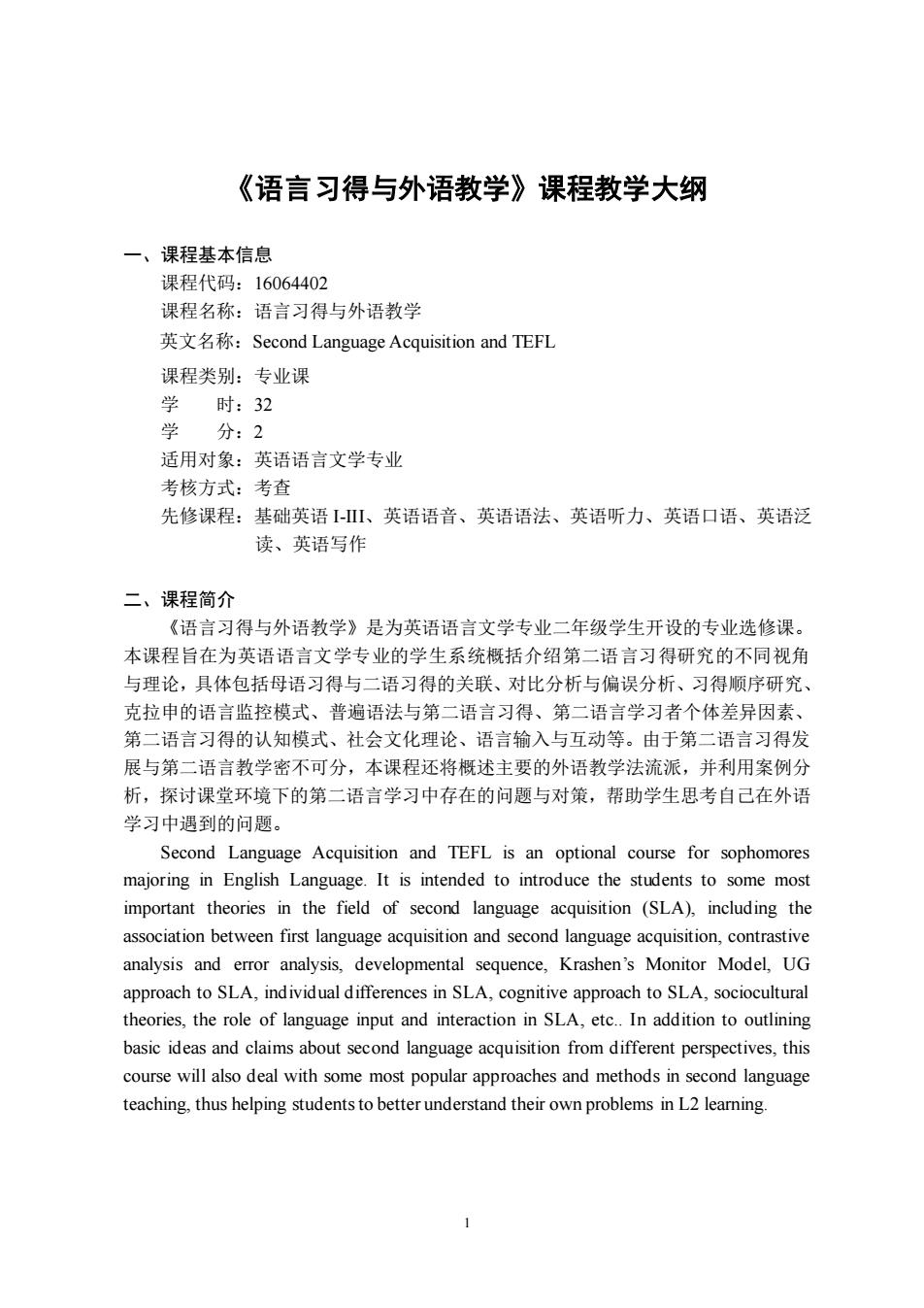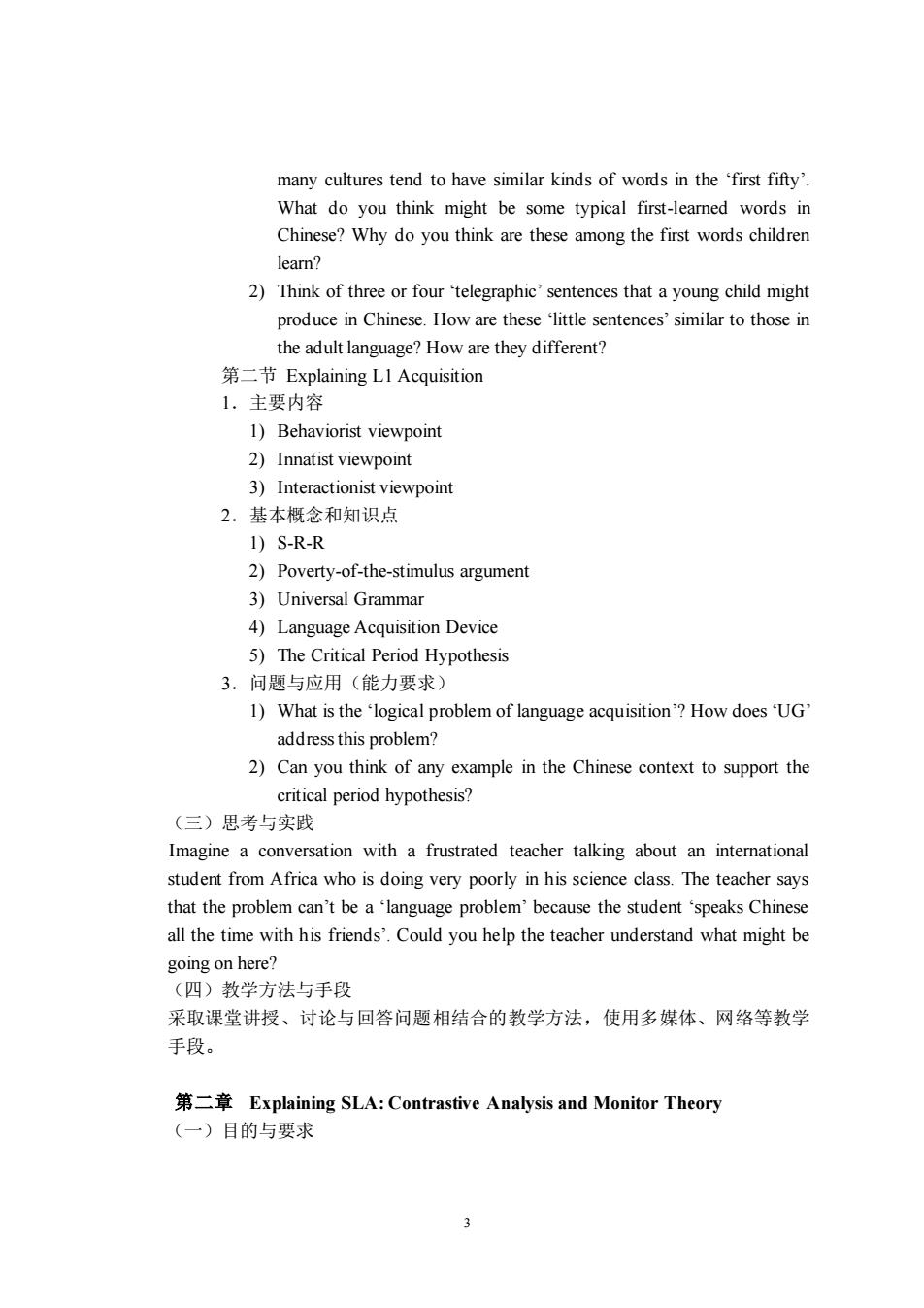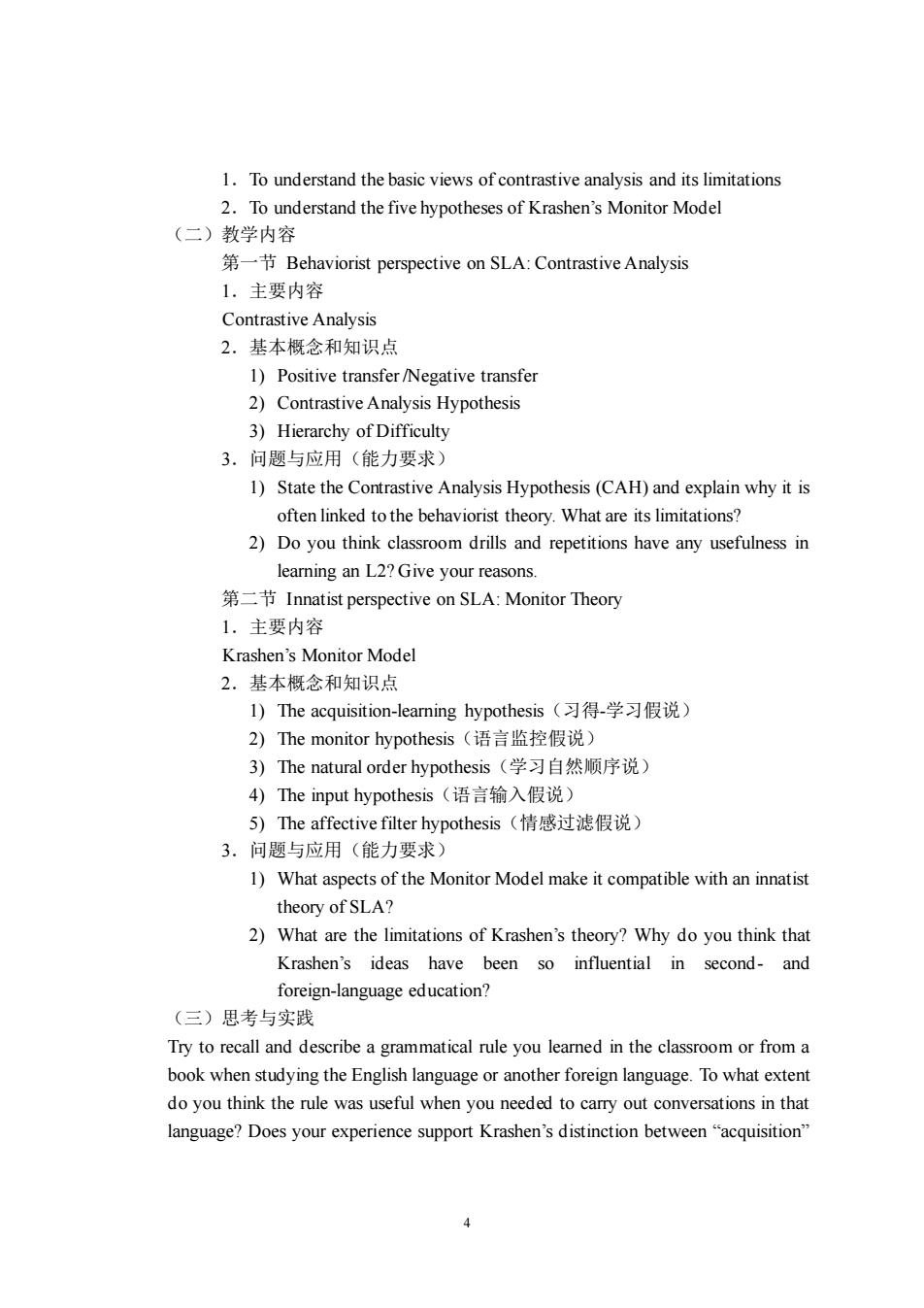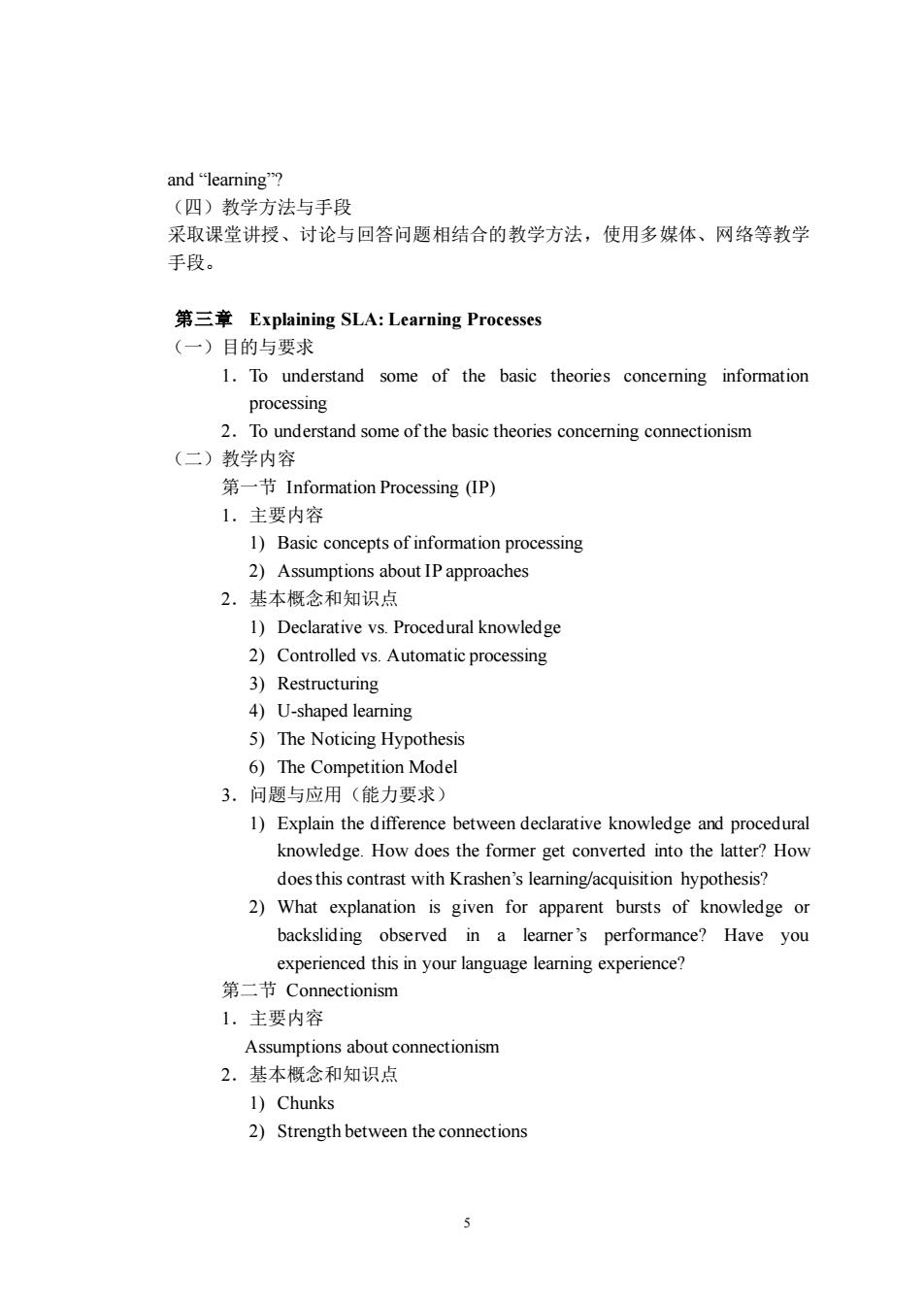
《语言习得与外语教学》课程教学大纲 一、课程基本信息 课程代码:16064402 课程名称:语言习得与外语教学 英文名称:Second Language Acquisition and TEFL 课程类别:专业课 学时:32 学 分:2 适用对象:英语语言文学专业 考核方式:考查 先修课程:基础英语、英语语音、英语语法、英语听力、英语口语、英语污 读、英语写作 二、课程简介 《语言习得与外语教学》是为英语语言文学专业二年级学生开设的专业选修课 本课程旨在为英语语言文学专业的学生系统概括介绍第二语言习得研究的不同视角 与理论,具体包括母语习得与二语习得的关联、对比分析与偏误分析、习得顺序研究 克拉申的语言监控模式、普遍语法与第二语言习得、第二语言学习者个体差异因素、 第二语言习得的认知模式、社会文化理论、语言输入与互动等。由于第二语言习得发 展与第二语言教学密不可分,本课程还将概述主要的外语教学法流派,并利用案例分 析,探讨课堂环境下的第二语言学习中存在的问题与对策,帮助学生思考自己在外语 学习中遇到的问颗。 Second Language Acquisition and TEFL is an optional course for sophomores majoring in English Language.It is intended to introduce the students to some most important theories in the field of second language acquisition (SLA).including the association between first language acquisition and second language acquisition,contrastive analysis and error analysis,developmental sequence,Krashen's Monitor Model,UG approach to SLA,individual differences in SLA,cognitive approach to SLA.sociocultural theories,the role of language input and interaction in SLA,etc..In addition to outlining basic ideas and claims about second language acquisition from different perspectives,this course will also deal with some most popular approaches and methods in second language teaching.thus helping studentsto betterunderstand their own problems in L2 leaming
1 《语言习得与外语教学》课程教学大纲 一、课程基本信息 课程代码:16064402 课程名称:语言习得与外语教学 英文名称:Second Language Acquisition and TEFL 课程类别:专业课 学 时:32 学 分:2 适用对象:英语语言文学专业 考核方式:考查 先修课程:基础英语 I-III、英语语音、英语语法、英语听力、英语口语、英语泛 读、英语写作 二、课程简介 《语言习得与外语教学》是为英语语言文学专业二年级学生开设的专业选修课。 本课程旨在为英语语言文学专业的学生系统概括介绍第二语言习得研究的不同视角 与理论,具体包括母语习得与二语习得的关联、对比分析与偏误分析、习得顺序研究、 克拉申的语言监控模式、普遍语法与第二语言习得、第二语言学习者个体差异因素、 第二语言习得的认知模式、社会文化理论、语言输入与互动等。由于第二语言习得发 展与第二语言教学密不可分,本课程还将概述主要的外语教学法流派,并利用案例分 析,探讨课堂环境下的第二语言学习中存在的问题与对策,帮助学生思考自己在外语 学习中遇到的问题。 Second Language Acquisition and TEFL is an optional course for sophomores majoring in English Language. It is intended to introduce the students to some most important theories in the field of second language acquisition (SLA), including the association between first language acquisition and second language acquisition, contrastive analysis and error analysis, developmental sequence, Krashen’s Monitor Model, UG approach to SLA, individual differences in SLA, cognitive approach to SLA, sociocultural theories, the role of language input and interaction in SLA, etc.. In addition to outlining basic ideas and claims about second language acquisition from different perspectives, this course will also deal with some most popular approaches and methods in second language teaching, thus helping students to better understand their own problems in L2 learning

三、课程性质与教学目的 本课程全面介绍第二语言习得研究的内容、性质、所涵盖的子领域,以及相关的 经典理论及研究成果。通过本课程的学习,学生能够熟悉第二语言习得研究的历史、 现状、发展趋势以及第二语言习得与其他研究领域的关系,掌握从语言、认知、社会 文化等方面认识第二语言习得和使用的过程和规律,了解课堂环境下的第二语言学习 中存在的问题与对策,从而思考自己在外语学习中遇到的问题,树立正确的语言观, 并为今后在第二语言习得研究领域进一步深入学习打下一定的基础。除此之外,本课 程引导学生将相关知识融会贯通,结合外国人学习汉语的例子,探索如何更有效地在 课堂内外传播汉语语言知识,最终达到以语言为载体,弘扬中华文化的目的。 四、教学内容及要求 第一章First Language Acquisition (一)目的与要求 1.To understand the main features of different stages of Ll development: 2.To understand Behaviorist views on LI development: 3.To understand Innatist views on LI development; 4.To understand Interactionist views on LI developmen (二)教学内容 第一节Child LI Acquisitior 1.主要内容 1)The first three years 2)The pre-school years 3)The School year 2.基本概念和知识点 1)Crying 2)Cooing 3)Babbling 4)One-word stage 5)Two-word stage/Telegraphic Speech 6)Developmental sequence of grammatical morphemes 7)Developmental sequence of negation 8)Developmental sequence of question formation 9)Metalinguistic awareness 3.问题与应用(能力要求) 1)Child language acquisition researchers have found that children across 2
2 三、课程性质与教学目的 本课程全面介绍第二语言习得研究的内容、性质、所涵盖的子领域,以及相关的 经典理论及研究成果。通过本课程的学习,学生能够熟悉第二语言习得研究的历史、 现状、发展趋势以及第二语言习得与其他研究领域的关系,掌握从语言、认知、社会 文化等方面认识第二语言习得和使用的过程和规律,了解课堂环境下的第二语言学习 中存在的问题与对策,从而思考自己在外语学习中遇到的问题,树立正确的语言观, 并为今后在第二语言习得研究领域进一步深入学习打下一定的基础。除此之外,本课 程引导学生将相关知识融会贯通,结合外国人学习汉语的例子,探索如何更有效地在 课堂内外传播汉语语言知识,最终达到以语言为载体,弘扬中华文化的目的。 四、教学内容及要求 第一章 First Language Acquisition (一)目的与要求 1.To understand the main features of different stages of L1 development; 2.To understand Behaviorist views on L1 development; 3.To understand Innatist views on L1 development; 4.To understand Interactionist views on L1 development (二)教学内容 第一节 Child L1 Acquisition 1.主要内容 1) The first three years 2) The pre-school years 3) The School years 2.基本概念和知识点 1) Crying 2) Cooing 3) Babbling 4) One-word stage 5) Two-word stage /Telegraphic Speech 6) Developmental sequence of grammatical morphemes 7) Developmental sequence of negation 8) Developmental sequence of question formation 9) Metalinguistic awareness 3.问题与应用(能力要求) 1) Child language acquisition researchers have found that children across

many cultures tend to have similar kinds of words in the first fifty What do you think might be some typical first-leamned words in Chinese?Why do you think are these among the first words children learn? 2)Think of three or four 'telegraphic'sentences that a young child might produce in Chinese.How are these 'little sentences'similar to those in the adult language?How are they different? 第二节Explaining LI Acquisition 1.主要内容 1)Behaviorist viewpoint 2)Innatist viewpoint 3)Interactionist viewpoint 2.基本概念和知识点 1)S-R-R 2)Poverty-of-the-stimulus argument 3)Universal Grammar 4)Language Acquisition Device 5)The Critical Period Hypothesis 3.问题与应用(能力要求 1)What is the 'logical problem of language acquisition'?How doesUG' address this problem? 2)Can you think of any example in the Chinese context to support the critical period hypothesis? (三)思考与实践 Imagine a conversation with a frustrated teacher talking about an international student from Africa who is doing very poorly in his science class.The teacher says that the problem can't be a'language problem'because the student 'speaks Chinese all the time with his friends'.Could you help the teacher understand what might be going on here? (四)教学方法与手段 采取课堂讲授、讨论与回答问题相结合的教学方法,使用多媒体、网络等教学 毛段。 第二章Explaining SLA:Contrastive Analysis and Monitor Theory (一)目的与要求 3
3 many cultures tend to have similar kinds of words in the ‘first fifty’. What do you think might be some typical first-learned words in Chinese? Why do you think are these among the first words children learn? 2) Think of three or four ‘telegraphic’ sentences that a young child might produce in Chinese. How are these ‘little sentences’ similar to those in the adult language? How are they different? 第二节 Explaining L1 Acquisition 1.主要内容 1) Behaviorist viewpoint 2) Innatist viewpoint 3) Interactionist viewpoint 2.基本概念和知识点 1) S-R-R 2) Poverty-of-the-stimulus argument 3) Universal Grammar 4) Language Acquisition Device 5) The Critical Period Hypothesis 3.问题与应用(能力要求) 1) What is the ‘logical problem of language acquisition’? How does ‘UG’ address this problem? 2) Can you think of any example in the Chinese context to support the critical period hypothesis? (三)思考与实践 Imagine a conversation with a frustrated teacher talking about an international student from Africa who is doing very poorly in his science class. The teacher says that the problem can’t be a ‘language problem’ because the student ‘speaks Chinese all the time with his friends’. Could you help the teacher understand what might be going on here? (四)教学方法与手段 采取课堂讲授、讨论与回答问题相结合的教学方法,使用多媒体、网络等教学 手段。 第二章 Explaining SLA: Contrastive Analysis and Monitor Theory (一)目的与要求

1.To understand the basic views of contrastive analysis and its limitations 2.To understand the five hypotheses of Krashen's Monitor Model (二)教学内容 Behaviorist perspective on SLA:Contrastive Analysis 1.主要内容 Contrastive Analysis 2.基本概念和知识点 1)Positive transfer/Negative transfer 2)Contrastive Analysis Hypothesis 3)Hierarchy of Difficulty 3.问题与应用(能力要求) 1)State the Contrastive Analysis Hypothesis(CAH)and explain why it is often linked to the behaviorist theory.What are its limitations? 2)Do you think classroom drills and repetitions have any usefulness in leaming an L2?Give your reasons 第二节Innatist perspective on SLA:Monitor Theory 1.主要内容 Krashen's Monitor Model 2.基本概念和知识点 I)The acquisition-learning hypothesis(习得-学习假说) 2)The monitor hypothesis(语言监控假说) 3)The natural order hypothesis(学习自然顺序说) 4)The input hypothesis(语言输入假说) 5)The affective filter hypothesis(情感过滤假说) 3.问题与应用(能力要求 1)What aspects of the Monitor Model make it compatible with an innatist theory ofSLA? 2)What are the limitations of Krashen's theory?Why do you think that Krashen's ideas have been so influential in second-and foreign-language education? (三)思考与实践 Try to recall and describe a grammatical rule you learned in the classroom or from a book when studying the English language or another foreign language.To what extent do you think the rule was useful when you needed to camry out conversations in that language?Does your experience support Krashen's distinction between"acquisition' 4
4 1.To understand the basic views of contrastive analysis and its limitations 2.To understand the five hypotheses of Krashen’s Monitor Model (二)教学内容 第一节 Behaviorist perspective on SLA: Contrastive Analysis 1.主要内容 Contrastive Analysis 2.基本概念和知识点 1) Positive transfer /Negative transfer 2) Contrastive Analysis Hypothesis 3) Hierarchy of Difficulty 3.问题与应用(能力要求) 1) State the Contrastive Analysis Hypothesis (CAH) and explain why it is often linked to the behaviorist theory. What are its limitations? 2) Do you think classroom drills and repetitions have any usefulness in learning an L2? Give your reasons. 第二节 Innatist perspective on SLA: Monitor Theory 1.主要内容 Krashen’s Monitor Model 2.基本概念和知识点 1) The acquisition-learning hypothesis(习得-学习假说) 2) The monitor hypothesis(语言监控假说) 3) The natural order hypothesis(学习自然顺序说) 4) The input hypothesis(语言输入假说) 5) The affective filter hypothesis(情感过滤假说) 3.问题与应用(能力要求) 1) What aspects of the Monitor Model make it compatible with an innatist theory of SLA? 2) What are the limitations of Krashen’s theory? Why do you think that Krashen’s ideas have been so influential in second- and foreign-language education? (三)思考与实践 Try to recall and describe a grammatical rule you learned in the classroom or from a book when studying the English language or another foreign language. To what extent do you think the rule was useful when you needed to carry out conversations in that language? Does your experience support Krashen’s distinction between “acquisition

and"learning"? (四)教学方法与手段 采取课堂讲授、讨论与回答问题相结合的教学方法,使用多媒体、网络等教学 手段 第三章Explaining SLA:Learning Processes (一)目的与要求 1.To understand some of the basic theories concerning information processing 2.To understand some of the basic theories conceming connectionism (二)教学内容 第一节Information Processing(IP) 1.主要内容 1)Basic concepts of information processing 2)Assumptions about IPapproaches 2.基本概念和知识点 1)Declarative vs.Procedural knowledge 2)Controlled vs.Automatic processing 3)Restructuring 4)U-shaped learning 5)The Noticing Hypothesis 6)The Competition Model 3.问题与应用(能力要求) 1)Explain the difference between declarative knowledge and procedural knowledge.How does the former get converted into the latter?How does this contrast with Krashen's learning/acquisition hypothesis? 2)What explanation is given for apparent bursts of knowledge or backsliding observed in a learner's performance?Have you experienced this in your language learning experience? 第二节Connectionism 1.主要内容 Assumptions about connectionism 2.基本概念和知识点 1)Chunks 2)Strength between the connections 5
5 and “learning”? (四)教学方法与手段 采取课堂讲授、讨论与回答问题相结合的教学方法,使用多媒体、网络等教学 手段。 第三章 Explaining SLA: Learning Processes (一)目的与要求 1.To understand some of the basic theories concerning information processing 2.To understand some of the basic theories concerning connectionism (二)教学内容 第一节 Information Processing (IP) 1.主要内容 1) Basic concepts of information processing 2) Assumptions about IP approaches 2.基本概念和知识点 1) Declarative vs. Procedural knowledge 2) Controlled vs. Automatic processing 3) Restructuring 4) U-shaped learning 5) The Noticing Hypothesis 6) The Competition Model 3.问题与应用(能力要求) 1) Explain the difference between declarative knowledge and procedural knowledge. How does the former get converted into the latter? How does this contrast with Krashen’s learning/acquisition hypothesis? 2) What explanation is given for apparent bursts of knowledge or backsliding observed in a learner’s performance? Have you experienced this in your language learning experience? 第二节 Connectionism 1.主要内容 Assumptions about connectionism 2.基本概念和知识点 1) Chunks 2) Strength between the connections